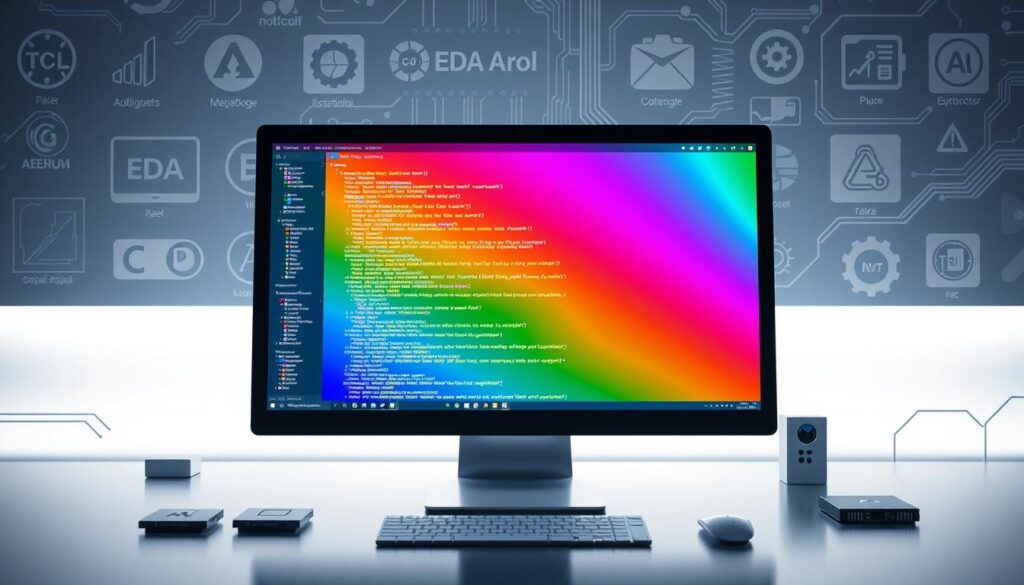TCL (Tool Command Language) has become a crucial scripting language in the VLSI design industry, particularly in the realm of physical design automation. With its versatile capabilities, we can leverage TCL to streamline repetitive tasks, expand the functionality of EDA tools, manage multiple tools through a single script, and even develop custom graphical user interfaces (GUIs) for enhanced user experience.
The ubiquity of TCL in VLSI design can be attributed to its ability to seamlessly integrate with major EDA tools, providing designers an interactive shell to automate their workflows. From managing file operations and data manipulation to orchestrating complex design flows, TCL empowers us to enhance productivity and efficiency throughout the physical design process.
As the VLSI industry continues to evolve, the importance of TCL scripting in physical design automation has only grown. By leveraging this powerful scripting language, we can streamline our design processes, reduce the risk of manual errors, and ultimately deliver more robust and reliable semiconductor products to the market.
Table of Contents
Understanding TCL as a Scripting Language in VLSI Design
Tcl, or Tool Command Language, has emerged as a popular scripting language in the world of VLSI design. Its interpreted nature and dynamic capabilities make it a preferred choice for various automation and integration tasks within the VLSI workflow. As an interpreted language, Tcl eliminates the need for compilation, allowing developers to execute code immediately within the Tcl shell or the VLSI-EDA tool’s shell.
Key Features of TCL as an Interpreted Language
One of the primary advantages of Tcl is its interpreted nature, which enables rapid prototyping and real-time code execution. Tcl scripts can be modified and run without the need for a lengthy compilation process, streamlining the development and testing phases. This dynamic scripting approach is particularly valuable in VLSI design, where flexibility and agility are essential.
Dynamic Nature and Real-time Code Execution
Tcl’s dynamic nature allows for on-the-fly code changes and immediate execution, making it well-suited for VLSI design tasks that require rapid adaptation and iteration. Developers can quickly update their scripts and see the results without the overhead of recompiling the entire codebase. This real-time code execution capability enhances productivity and enables more efficient exploration of design alternatives.
Cross-platform Compatibility Benefits
Another key advantage of Tcl is its cross-platform compatibility, which allows scripts to be written on one operating system and seamlessly executed on another. This versatility is particularly valuable in the VLSI industry, where design teams often work across different platforms and environments. The ability to reuse Tcl scripts across various operating systems, including Windows, macOS, and Unix-based systems, streamlines VLSI design workflows and enhances collaboration among team members.
Tcl’s powerful data structures, scripting capabilities, and data-mining features make it a versatile tool for handling the large volumes of design data encountered in VLSI projects. Its widespread adoption in the VLSI industry underscores its importance as a crucial scripting language for automation, integration, and tool-specific customization tasks.
TCL Scripting in PD: Core Applications and Usage
TCL, or Tool Command Language, is a versatile scripting language widely adopted in the physical design (PD) automation domain of VLSI design. This interpreted language plays a crucial role in streamlining various processes within physical design automation, from placement and routing to ASIC design and EDA tools integration.
TCL scripting allows designers to automate repetitive tasks, perform design queries, and control benchmarking parameters in physical design. The language’s dynamic nature and cross-platform compatibility make it an attractive choice for physical design automation workflows, enhancing productivity and reducing manual intervention.
One of the core applications of TCL scripting in physical design is the automation of placement and routing (PnR) processes. TCL scripts enable designers to customize and optimize the PnR flow, automating critical steps and ensuring consistent, high-quality results. Additionally, TCL is widely used for design queries, enabling designers to extract and analyze relevant data from their physical designs.
Furthermore, TCL’s seamless integration with EDA tools, such as Cadence, Synopsys, and Mentor Graphics, allows designers to write custom scripts for specific design tasks. This integration empowers designers to extend the capabilities of these tools, tailoring them to their unique requirements and streamlining the overall physical design process.
| TCL Scripting in Physical Design: Key Applications | Benefits |
|---|---|
|
|
In summary, TCL scripting has become an indispensable tool in the realm of physical design automation, enabling designers to streamline their workflows, enhance productivity, and deliver optimized physical design automation solutions. Its versatility and integration with EDA tools make it a valuable asset in the VLSI design ecosystem.

Essential Components of TCL for Physical Design Automation
As a versatile scripting language, TCL offers a suite of powerful features that are indispensable for physical design (PD) automation in the VLSI industry. From its built-in data structures to its robust control structures and regular expression capabilities, TCL provides a comprehensive toolkit to streamline design management and drive efficiency across the PD workflow.
Built-in Data Structures and Arrays
TCL’s native data structures, including lists, arrays, and dictionaries, are particularly useful for handling the vast amounts of design data encountered in PD. These data structures enable efficient organization, processing, and manipulation of information such as net lists, placement data, and routing details. Developers can leverage TCL’s intuitive syntax to create, access, and modify these data structures, facilitating seamless integration with various EDA tools and design flows.
Control Structures for Design Management
TCL’s control structures, such as if, while, foreach, for, and switch, provide the necessary flexibility to automate complex design management tasks. These constructs allow designers to implement sophisticated decision-making logic, iterative processes, and conditional execution, enabling them to address a wide range of design scenarios efficiently. The ability to combine these control structures with TCL’s data structures further enhances the language’s utility in the PD domain.
Regular Expression Engine Capabilities
TCL’s robust regular expression engine, comparable to Perl or Python, is particularly valuable in physical design automation. The ability to leverage powerful pattern-matching capabilities allows designers to process and filter large numbers of nets, cells, and other design entities with ease. This feature is instrumental in tasks like net renaming, design rule checking, and design data parsing, contributing to the overall efficiency and accuracy of the PD workflow.
These essential components of TCL, coupled with its widespread adoption in the VLSI industry, make it a cornerstone of physical design automation. By leveraging TCL’s data structures, control structures, and regular expression capabilities, designers can streamline their processes, enhance productivity, and ensure the integrity of their ASIC and SoC designs.
Integration of TCL with EDA Tools and Design Flow
The integration of TCL scripting with Electronic Design Automation (EDA) tools is a crucial aspect of modern VLSI design workflows. TCL, the Tool Command Language, seamlessly integrates with leading EDA tools, providing designers an interactive shell to execute commands and scripts directly within the design environment.
This integration allows TCL to interact with the design under test (DUT), granting access and control over design data in real-time. EDA vendors offer tool-specific Application Programming Interfaces (APIs) that can be utilized in conjunction with TCL scripts to automate various stages of the design flow, from synthesis to place-and-route and beyond.
The TCL shell serves as a powerful engine for VLSI designers, enabling them to conduct quick queries and obtain immediate responses for any part of the design. This interactive nature of TCL scripting streamlines the design process, boosts productivity, and ensures smooth collaboration across different design stages.
TCL’s Role in Design Flow Automation
TCL scripting plays a pivotal role in automating and streamlining VLSI design flows. By leveraging TCL’s capabilities, designers can:
- Automate repetitive tasks, such as file management, design rule checks, and parameter sweeps
- Integrate various EDA tools seamlessly, ensuring efficient data exchange and cross-stage collaboration
- Customize design environments to suit specific project requirements, enhancing reusability and maintainability
- Facilitate efficient debugging and verification of VLSI designs, improving overall quality and reliability
The seamless integration of TCL with EDA tool integration and design flow automation has become a cornerstone of modern VLSI design practices, empowering designers to work more efficiently and productively.
| Key Benefits of TCL Integration with EDA Tools | Description |
|---|---|
| Automation and Scripting | TCL enables VLSI designers to automate mundane tasks and streamline workflows, boosting productivity and efficiency. |
| Design Flows and Tool Integration | TCL serves as the glue that seamlessly integrates different tools and components within VLSI design flows, ensuring smooth collaboration across design stages. |
| Customization and Flexibility | TCL’s versatility allows VLSI engineers to tailor design environments according to specific project requirements, enhancing design reusability, modularity, and maintainability. |
| Debugging and Verification | TCL’s interactive nature facilitates efficient debugging and verification of VLSI designs, leading to improved design quality and reliability. |
The seamless integration of TCL with EDA tool integration and design flow automation has become a cornerstone of modern VLSI design practices, empowering designers to work more efficiently and productively.

TCL’s Role in Front-End Synthesis and Backend Design
Tcl (Tool Command Language) plays a pivotal role in streamlining both the front-end synthesis and backend design processes within the VLSI (Very Large-Scale Integration) design landscape. This versatile scripting language has become an indispensable tool for automating critical tasks, enhancing efficiency, and driving innovation across various stages of the design flow.
Synthesis Tool Integration Methods
In the front-end synthesis phase, Tcl scripts are extensively utilized to automate the synthesis process following the initial RTL (Register Transfer Level) coding and simulation. Tcl provides a seamless interface to integrate with synthesis tools, allowing designers to customize parameters, execute design queries, and generate comprehensive reports. This level of automation not only accelerates the synthesis process but also ensures consistent and reproducible results, ultimately contributing to the overall design quality.
Place and Route Automation Techniques
Moving to the backend design, Tcl scripts play a crucial role in the place and route (PnR) process. PnR tools leverage Tcl to automate various aspects of the layout implementation, such as floorplanning, cell placement, routing, and design optimization. By automating these complex tasks, Tcl scripts enable designers to explore more design iterations, experiment with different optimization strategies, and achieve faster turnaround times, all while maintaining design integrity.
Static Timing Analysis Applications
Tcl scripts are also extensively used in the static timing analysis (STA) phase, both in the front-end and backend stages of the design flow. Tcl provides a powerful interface to control STA parameters, extract timing information, and generate comprehensive reports. This level of control and automation ensures that designers can effectively analyze the timing characteristics of their designs, identify and address any timing violations, and ultimately deliver high-performance, reliable circuits.
The integration of Tcl scripting within the front-end synthesis, backend design, and static timing analysis processes has significantly streamlined the overall VLSI design flow. By leveraging the versatility and automation capabilities of Tcl, designers can enhance productivity, improve design quality, and accelerate the entire design cycle, ultimately delivering innovative and competitive products to the market.
Design Under Test (DUT) Interaction Through TCL
As physical designers, we can leverage the power of TCL scripting to directly interact with the Design Under Test (DUT) through the EDA tool’s TCL shell. This interaction allows us to inspect large designs, perform crucial verification queries, and extract relevant data from the design.
The TCL shell provides a live environment where the entire design data is accessible, enabling us to respond immediately to queries about any part of the design. This capability is particularly valuable for design verification and quick checks during the physical design process.
For example, we can use TCL queries to:
- Identify critical paths and potential bottlenecks in the design
- Extract timing and power data for specific design blocks
- Perform design rule checks and identify potential layout issues
- Automate the creation of test benches and stimulus files for design verification
By leveraging the DUT interaction capabilities of TCL, we can streamline the design verification process, reduce the risk of human error, and ensure the design meets its performance and reliability requirements.
| Statistic | Value |
|---|---|
| Errors in the VLSI design process due to human error | 91% |
| Redundancy as the most costly but highly efficient approach used for ASICs | Most widely employed |
| Functional Verification approaches in VLSI design using the Black Box Approach | 76% |
| Test Benches in VLSI design mimicking the environment where the design will operate | 85% |
| Formal verification methods in VLSI design using Equivalence Checking and Model Checking | 63% |
API Integration and Tool Communication Framework
In the world of VLSI design, EDA tool vendors provide robust and powerful APIs (Application Programming Interfaces) that can be seamlessly integrated with TCL (Tool Command Language) scripts. These APIs serve as a crucial interface layer, allowing designers to query, manipulate, and automate various aspects of the design process.
Understanding Tool-specific APIs
Each EDA tool typically offers its own set of specialized APIs, tailored to the specific needs and features of the tool. Mastering these tool-specific APIs is essential for maximizing the potential of TCL scripting in physical design automation. By leveraging these APIs, designers can access and control the live design data, perform advanced design analysis, and automate repetitive tasks, enhancing overall productivity and efficiency.
Command Interface Architecture
The command interface architecture provides the necessary framework for TCL scripts to communicate with the underlying EDA tools. This architecture enables TCL scripts to pass through multiple layers, from the TCL shell to the live design data structures, facilitating seamless interaction and data exchange. Understanding the nuances of this command interface is crucial for effectively integrating TCL scripting into the physical design workflow.
By mastering the integration of TCL scripting with EDA tool APIs and the command interface architecture, designers can unlock the full potential of automation and optimization in physical design. This powerful combination allows for streamlined design processes, reduced turnaround times, and enhanced design quality, ultimately driving innovation in the ever-evolving VLSI landscape.
Performance Optimization and Script Management
While TCL may not match the raw speed of compiled languages, it offers sufficient performance for most physical design automation tasks. By employing proper script management and optimization techniques, we can enhance the efficiency of our TCL scripts and streamline our physical design workflows.
One key aspect is the efficient use of TCL’s data structures and arrays. By carefully selecting the right data structures and minimizing repetitive parsing, we can significantly boost script performance. Additionally, leveraging tool-specific optimizations, such as those provided by the EDA tools we integrate with, can further enhance the speed and responsiveness of our TCL scripts.
Organizing our TCL scripts into reusable procedures and packages not only improves code maintainability but also contributes to execution efficiency. This modular approach allows us to encapsulate common tasks, reducing redundancy and ensuring consistent script behavior across complex physical design flows. By continuously refining our script management practices, we can optimize script optimization, TCL efficiency, and overall performance tuning in our daily physical design activities.
Source Links
- TCL Practice Task 1 (Scripting Language)
- 25+ Tcl Interview Questions For Tech Interviews – CoderPad
- TCL Scripting For VLSI: A Brief Guide
- Top 20 TCL syntax helpful to improve TCL scripting skill for VLSI Engineers – Team VLSI
- TCL Scripting For VLSI Part 1
- Pd GUI Rewrite progress
- TclBlend Problems
- Arnob K. on LinkedIn: Tcl Cheat Sheet | 10 comments
- ROADMAP TO START YOUR CAREER IN VLSI
- Microsoft PowerPoint – oaPDK2iPDK.pptx
- A vaccine for Alzheimer’s is on the verge of becoming a reality
- Variable Domain-specific Software Languages with DjDSL: Design and Implementation [1st ed.] 9783030421519, 9783030421526 – DOKUMEN.PUB
- comp.lang.tcl Frequently Asked Questions (Mar 05, 2005) (4/6)
- 2019 2 testing and verification of vlsi design_verification
- Application Programming Interfaces – DesignSafe User Guide
- Tcl 9.0 | Hacker News
- ECO Implementation Tips, which I learnt from my Physical Design Experience.

